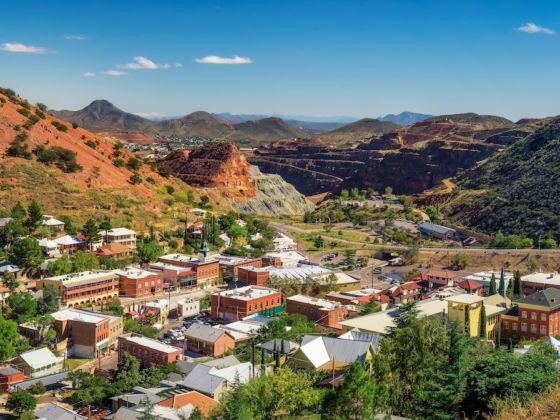PRESCOTT, Yavapai County
The small city of Prescott can feel a world away from the desert climate of Arizona’s south. In fact, Prescott can feel a world away from the rest of the Southwest.
The town was pushed into creation by Congress and Abraham Lincoln in 1864 as the territorial capital of Arizona, a move to secure the region’s natural resources for the Union during the Civil War. As result of this Yankee influence, Prescott’s architecture and grass-covered front yards had more in common with the Victorian vibe of the wider U.S. at the time than the otherwise unique aesthetics of the Southwest. While a massive fire in 1900 pressed the reset button, both culturally and architecturally, on the mountain town, much of the older flavor remains.
Whiskey Row is the contemporary center of Prescott’s nightlife, as it was 100 years ago, but this part of the state is best appreciated outdoors. Prescott’s 250 miles of mountain biking trails are nothing short of phenomenal (get your hike and ride maps here), as are hiking options like Thumb Butte and the Granite Mountain Trail. If you’re short on gear, Prescott has plenty of outfitters to help fill out whatever’s missing in your day bag.
PATAGONIA, Santa Cruz County
Patagonia is getting quite famous for being practically unknown. The town sits quietly 20 miles north of Mexico between two districts of the expansive Coronado National Forest, shaded by both the Santa Rita and Patagonia Mountains. With an elevation of just over 4,000 feet, its cooler climate attracts grassland bird watchers.
For most, though, the real draw to Patagonia is the wine. In the 1970s, a soil scientist by the name of Dr. Gordon Dutt discovered that the red earth around town was practically a match for that of Côte-d’Or in Burgundy, France. In the time since, close to a dozen vineyards have opened, and the area has been granted a federal designation as a unique wine-producing region.
Once you’ve gotten a little color in your cheeks, there are the nearby ghost towns of Harshaw, Duquesne, and Lochiel. The Stage Stop Inn in Patagonia gets high marks from travelers for value and decor.
BISBEE, Cochise County
Fifteen miles north of the Mexican border, creeping up the base of the red-clay-colored Mule Mountains, sits the former mining town of Bisbee. At the turn of the 20th century, the local Copper Queen Mine was one of the world’s most productive, churning out gold, copper, zinc, and lead. The population of well-paid miners and their somewhat lascivious hobbies helped earn Bisbee the informal title of “liveliest spot between El Paso and San Francisco.” But as mines boom they must also bust, and by the end of the 1970s things had quieted down.
But that was far from the end of the story for Bisbee. Since the miners moved out, artists have moved in, and today this small town — a good hour-and-a-half drive from the nearest city — is a creative enclave with an eccentric old-hippie spice. There’s a serious appreciation for the kitsch, and at times the town can feel like a John Waters fantasy of the Old West. Still, Main Street’s brick structures look as enduring as the Pyramids and as tough as the miners who once frequented them.
Bisbee’s best attractions are the tours of the mine and town. The Old Bisbee Ghost Tour will take you on a ghost hunt at the famous Copper Queen Hotel, or guide you on a haunted pub crawl. If you’re after a funky place to stay with some history — albeit a little less history than the hotels in town — look no further than the Shady Dell. The Dell is a stylized trailer park of ten vintage campers dating back to the late 1940s. Each has a unique theme and can be rented for between $90 and $150 per night.
JEROME, Yavapai County
About 100 miles due north of Phoenix, and a quick 50-minute drive from Prescott, the ghost town of Jerome shares many of the eccentric-artist charms and Old West history of Bisbee, while benefiting from the much cooler climate of Arizona’s north. It looks exactly as you might have expected it to 100 years ago, but the best views come when you put your back to the town. From its perch in the Black Hills of Prescott National Forest, Jerome’s sweeping panoramas of red mountains splotched in green desert shrubbery conjure thoughts of what Mars might look like after a good rain.
From their boom-to-bust mining histories, prevalence of artists, and past reputations as cities of ill repute, Jerome and Bisbee can’t escape constant comparison. When it comes to activities in Jerome, you would be well served, as you would in Bisbee, by a tour of haunted mines and hotels.
Ghosts are inseparably woven into Jerome’s identity; a favorite for a bite to eat is the Haunted Hamburger on Clark Street. The restaurant earned its name after a number of strange events involving disappearing tools and slamming doors occurred during the building’s renovation.
ARCOSANTI, Yavapai County
Arcosanti describes itself as an “urban laboratory” — a living experiment in founder Paolo Soleri’s theory of “arcology” (a combination of architecture and ecology). Established in the 1970s, the aim of arcology is to explore alternative architecture in the pursuit of environmental responsibility and alternatives to urban sprawl. If you’re looking for uniquely Arizona, this is it.
While Soleri’s ideals of living in harmony with the environment are as relevant as ever, the look of Arcosanti is a bit dated, something like a Jetsons vision of the future. But don’t be deterred — the high-domed apses and massive circular windows of the Sky Suite are remarkable sites that warrant the 70-mile drive north of Phoenix.
Arcosanti holds annual workshops that teach the founding concepts of the community. Every year the town hosts about 35,000 tourists who stop to stay the night, tour the buildings, ponder the concepts of arcology, and purchase the famous bronze and ceramic Arcosanti wind bells that are the economic lifeblood of the community.
WILLIAMS, Coconino County
Historic Route 66 once embodied the American spirit of risk, adventure, and perseverance. The 2,500-mile road was the nerve system of the West, carrying survivors of the Dust Bowl to greener pastures and supporting the communities that sat along its edges. The town of Williams, situated on what is now Interstate 40, about a half hour west of Flagstaff, is a living ode to both that storied road and the cultural high-water mark that was the1950s.
Today, Williams is still a town of neon signs, soda fountains, and restaurants that serve the American staples of cow and potatoes in all their various glories. This is a wonderful place to snap a few photos of Americana relics or buy some cowboy leather.
Williams is also the pickup point for the Grand Canyon Railway. The train ride takes about two hours and drops you off on the canyon’s South Rim. There are a number of class options, including an observation dome and the budget-minded Pullman Class.
LAKE HAVASU CITY, Mohave County
If Arcosanti is an exercise in living with the environment, Lake Havasu City is an engineering victory over Mother Nature. The town’s desert climate is unmistakably arid, yet it earns its dot on the map for its tremendous water sports, made possible by the Parker Dam on the Colorado River, which creates the massive namesake reservoir. In what other landlocked desert town can you find beaches, boating, and fishing?
Make no mistake — Lake Havasu City was created for your good times. Every year, thousands of nubile bodies descend on the lake for one of the rowdiest Spring Break events north of the border. During any other week of the year, this is a great place to bring the family, get out on the water, and of course see the meticulous reconstruction of the London Bridge (featuring original masonry that was purchased, tagged, and shipped to town following the bridge’s renovation in the 1960s).
And you thought you had to leave Arizona to see the world?

